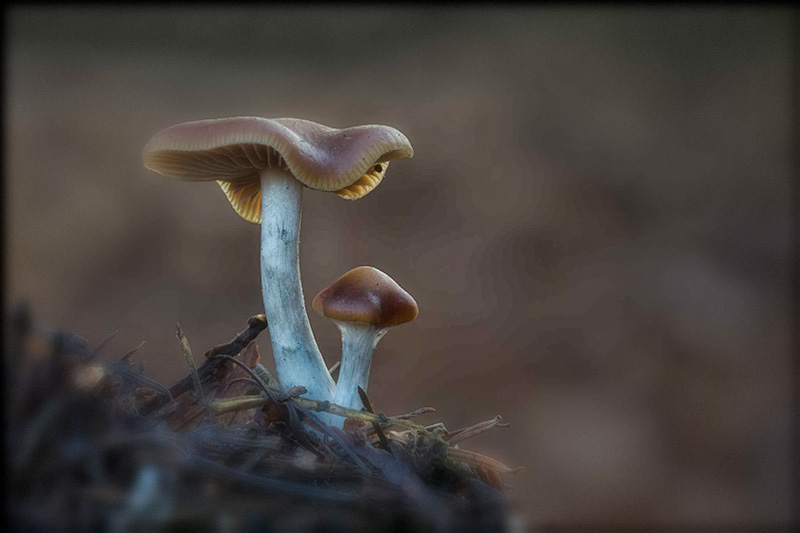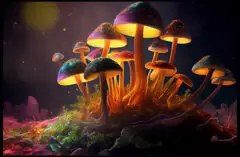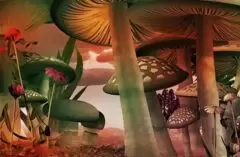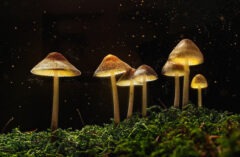Table of Contents
Last Updated on April 16, 2024 by Team Spinfuel

[ez-toc]Psilocybin mushrooms, colloquially known as “magic mushrooms,” are a category of fungi that contain the naturally occurring psychedelic compounds psilocybin and psilocin.
These species have been used for their psychoactive properties for thousands of years in many different cultures (Nichols, 2016). However, the mushrooms’ effects can vary greatly depending on the species, dosage, individual physiology, and mindset. The following are five of the best psilocybin mushroom species, known for their potency and relative safety, which can induce a quality psychedelic experience.
Psilocybe cubensis – Psilocybin Mushroom
Psilocybe cubensis is perhaps the most popular and easily recognizable psilocybin mushroom species due to its widespread distribution and ease of cultivation (Kerrigan, 2016). This species is well-known for inducing a balanced psychedelic experience marked by visual hallucinations, euphoria, altered perception of time, and introspection. Its potency is moderate, making it a suitable choice for both novice and experienced users. It is crucial, however, to adhere to proper dosage guidelines to ensure a safe and positive experience.
Psilocybe semilanceata (Liberty Cap) – Psilocybin Mushroom
Semilanceata, commonly known as the Liberty Cap, is a species native to the temperate areas of the Northern Hemisphere (Guzmán, 2005). This species is renowned for its potent effects, despite its small size. The Liberty Cap is often praised for inducing a more introspective and philosophical trip compared to other species. However, due to their potency, they should be used with caution, especially by beginners.
3. Psilocybe azurescens – Psilocybin Mushroom
Native to the Pacific Northwest of the United States, P. azurescens is considered one of the most potent psilocybin mushrooms (Stamets & Gartz, 1995). Its high psilocybin content can produce intense visual hallucinations and profound psychedelic experiences. Due to their potency, it is advised to start with a lower dose when experimenting with this species. Accurate identification is also essential, as they closely resemble several non-psychedelic and potentially harmful species.
4. Psilocybe cyanescens (Wavy Cap) – My Favorite
Cyanescens, or Wavy Cap, is another species indigenous to the Pacific Northwest but has spread to various parts of the world (Richardson, 2006). Similar to P. azurescens, Wavy Caps are very potent, delivering a strong, often visual, psychedelic experience. Like all species, proper identification is crucial to avoid harmful look-alikes.
Psilocybe cyanescens (Wavy Cap): A Closer Look
Wavy Cap has shown resilience and adaptability, spreading to different parts of the world, including parts of Europe, West Asia, and even Australasia (Richardson, 2006).
The Wavy Cap’s adaptive abilities are partially due to its wood-loving nature; this mushroom species tends to grow in deciduous woods, often on wood chips, especially in and around urban areas. Their growth season spans from September to December, favoring cool temperatures and high humidity (Stamets, 1996).
The primary active compounds in P. cyanescens are psilocybin, psilocin, and baeocystin. Among these, psilocybin is the most abundant, and it is responsible for the psychoactive properties of the species.
The mushrooms are typically medium to high in potency, producing a powerful psychedelic experience often characterized by pronounced visual hallucinations, a deep sense of introspection, and occasionally synesthesia, a crossover of sensory perceptions such as “hearing” colors or “seeing” sounds (Stamets, 1996).
Given its high potency, individuals looking to experiment with P. cyanescens should proceed with caution, starting with a low dose and gradually adjusting based on individual tolerance and response.
Incorrect dosage can lead to intense experiences that may result in anxiety, paranoia, or, in extreme cases, a bad psychedelic trip. As such, it’s always advisable to have a sober and trusted individual nearby when consuming P. cyanescens or any other psychedelic substance (Carhart-Harris et al., 2016).
While Psilocybe cyanescens offers a unique psychedelic experience, one of the major challenges with this species is its resemblance to several other non-psychedelic or toxic mushroom species. Proper identification is therefore crucial. Features to look out for include the distinct wavy cap, a dark purple-brown spore print, and a blue bruising reaction when the mushroom is damaged (Stamets, 1996).
As of July 2023, Psilocybe cyanescens and other psilocybin-containing mushrooms remain illegal in many jurisdictions. Always adhere to local laws and regulations and consider seeking advice from professionals before consuming these substances.
5. Psilocybe Mexicana – Psilocybin Mushroom
Mexicana holds a special place in the history of psilocybin mushrooms, as it was the species from which psilocybin was first isolated by Swiss chemist Albert Hofmann in 1958 (Hofmann, 1958). This species, native to Central and South America, offers a milder, more controlled psychedelic experience compared to the others on this list, making it an excellent choice for those new to psilocybin mushrooms.
Conclusion
While these species offer remarkable psychedelic experiences, it’s critical to note that the consumption of psilocybin mushrooms is not without risks. Possible effects include nausea, paranoia, and panic attacks (Carhart-Harris et al., 2016). Additionally, as of my knowledge cutoff in September 2021, they are still considered illegal in many jurisdictions. Always prioritize safety, adhere to local laws, and consider seeking advice from healthcare professionals or experienced guides before experimenting with these substances.
References
- Carhart-Harris, R. L., et al. (2016). Psilocybin with psychological support for treatment-resistant depression: An open-label feasibility study. The Lancet Psychiatry, 3(7), 619-627.
- Guzmán, G. (2005). Species diversity of the Genus Psilocybe (Basidiomycotina, Agaricales, Strophariaceae) in the World Mycobiota, with special attention to hallucinogenic properties. International Journal of Medicinal Mushrooms, 7(1-2).
- Hofmann, A. (1958). The active principles of the seeds of Rivea Corymbosa and Ipomoea violacea. Botanical Museum Leaflets, Harvard University, 18(6), 129-154.
- Kerrigan, R. W. (2016). Agaricales of California 13: Strophariaceae. Mad River Press.
- Nichols, D. E. (2016). Psychedelics. Pharmacological Reviews, 68(2), 264-355.
- Richardson, M. (2006). The Psilocybin Mushroom Bible: The Definitive Guide to Growing and Using Magic Mushrooms. Green Candy Press.
- Stamets, P., & Gartz, J. (1995). A new caerulescent Psilocybe from the Pacific Coast of Northwestern America. Integration, 6, 21-27.








